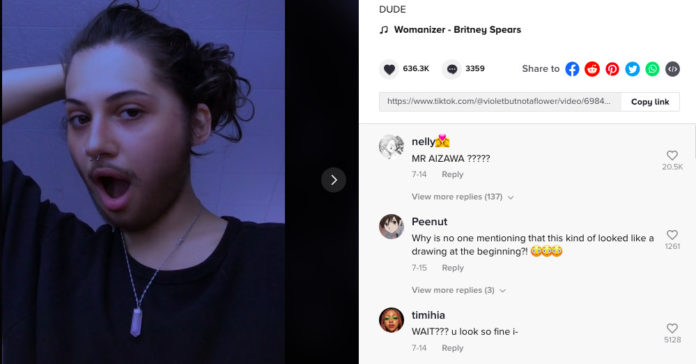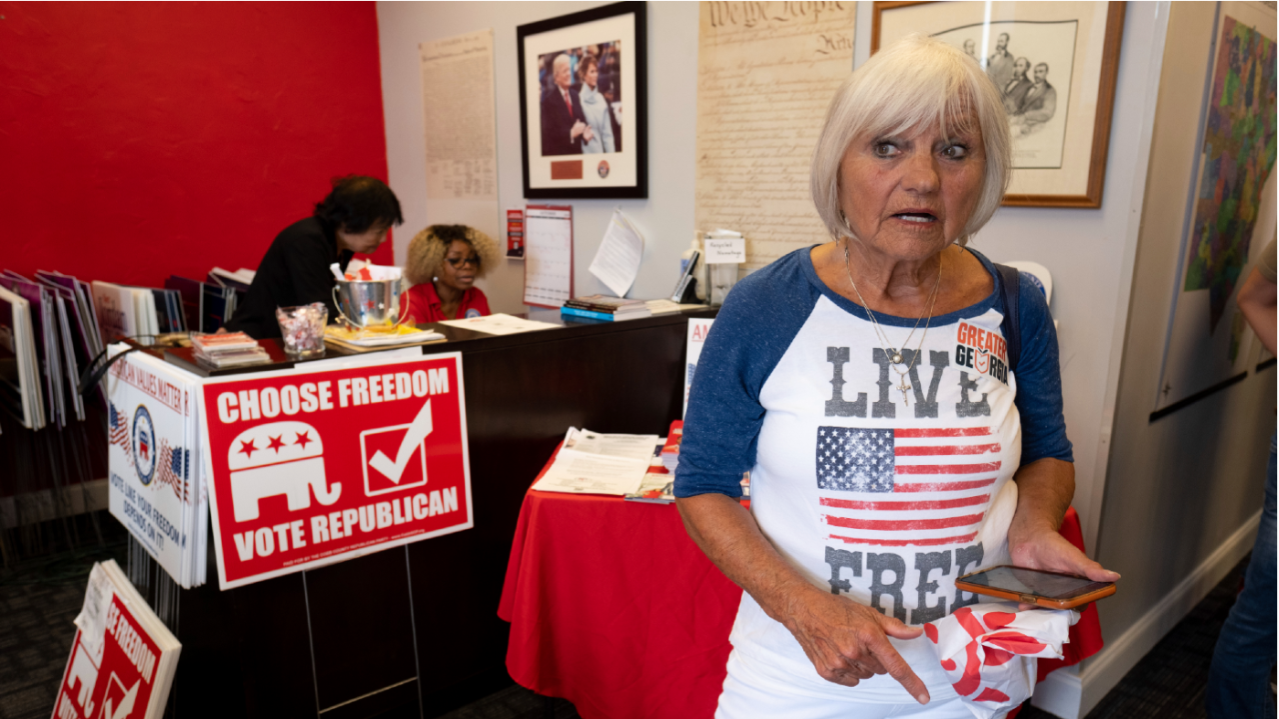
There’s a new trending filter on TikTok called Blue & Red. Its job is simple: Like many others before it, the Blue & Red filter transforms your face either with stereotypically masculine features (against a blue background) or with feminine features (against a red background). The difference is that you can switch between the two simply by blinking, and it first went viral as a way to lip-sync to a specific duet from In the Heights between a male and female character. For some users, it became a whole lot more.
“Feeling a lot of feelings,” says user @donniefitzzz, smiling with the red filter on. “Some might call it a crisis, almost, internally, is what this is giving me.” Donnie, whose bio says they use any pronouns, is enthralled by their face in the filter, clearly seeing themselves in quite literally a new light. “#Questioninggender,” they captioned the video, as well as “#idkifimtrans.”
It’s honestly a beautiful thing to witness, even though the video seemed to be created in a playful spirit. Many of the other videos that use the filter are also young people experiencing gender euphoria, or the feeling that one nonbinary person described as “a little shiny gender breakthrough,” while commenters shower compliments and praise.
The Blue & Red filter is just one example of how TikTok is providing spaces for people questioning their gender identities and sexualities to explore and connect with one another. Many of the most popular TikTok trends have been adopted as queer signals, whether via songs (Girl in Red’s “We Fell in Love in October” as a shorthand for lesbians and women loving women), fashion (cuffed pants and sleeves to signal bisexuality), emojis (the painted nails, for instance), or dance moves, as David Mack recently covered in a BuzzFeed piece on the limp wrist motion during the bell chime in Doja Cat’s “Kiss Me More.” It’s a way of identifying and expressing oneself, while also serving as something of an opening to connect with fellow queer people.
Queer signaling isn’t new, of course; the practice is as old as heteronormativity in the sense that queer people have long had to find ways to locate and communicate with one another. Whether due to the risk of being outed and punished, or simply a convenient method to find sexual partners, throughout history, folks have used fashion to signal kinks and sexual preferences (the hanky code, for instance). In 19th-century England, some gay and lesbian women used a secret language called Polari; in the ‘50s and ‘60s, it was common to ask, “Are you a friend of Dorothy?” to determine whether someone was gay.
One of the unique parts about TikTok, though, is that it’s a social media app that doesn’t necessarily connect you with the people you know in real life. Unlike on Facebook and Instagram, you could end up going massively viral on the app without your friends and family having any idea, which could allow you to speak more freely than you might otherwise. The other important part is its algorithm, which is legendarily good (and legendarily quick) at figuring out what you like and want to watch — sometimes before even you might know yourself.
Earlier this year, Mashable’s Jess Joho wrote about the strikingly common experience of having the TikTok algorithm realizing you’re bi before you do. “Looking back at my history of likes, the transition from queer ‘ally’ to ‘salivating simp’ is almost imperceptible,” she writes. I’ve stumbled across plenty of videos directed specifically toward women in hetero relationships who have, in adulthood, started to realize they’re “less heterosexual than they thought,” as one put it, or videos devoted to unlearning compulsive heterosexuality.
This is not to say that TikTok is an unwavering paradise for queer and questioning people. TikTok has censored queer content in certain countries to appease their governments, though has claimed this was aimed to “reduce cyberbullying.” I’ve also come across a disturbing amount of anti-trans videos, often created by young women sharing the sort of fear-mongering talking points typical among TERFs. There are also plenty of popular TikTokers who have been called out for “queerbaiting” for clout, though those accusations can get murky when you acknowledge that, often, “queerbaiting” is someone’s way of exploring their sexuality.
TikTok has never been a great place to have nuanced discussions. Its time limit (previously 60 seconds, now three minutes), chaotic commenting platform, and lack of a clear timeline make following conversations and debates next to impossible; it can turn into a hellscape of “chronically online” takes piled on top of one another extremely fast. But I would argue that it’s one of the best platforms for questioning people, who can allow their algorithm to take them on a journey that could eventually lead them to a more authentic and joyful place. Rather than stoking fears about how “TikTok turned me queer,” what TikTok reflects is a growing tendency toward more fluid definitions of gender and sexuality.
According to a 2016 report from the trend forecasting agency J. Walter Thompson Innovation Group, just 48 percent of Americans aged 13 to 20 identified as exclusively heterosexual, compared to 65 percent of those aged 21 to 34. A 2017 study from Ipsos Mori showed that young people are more likely to have a “less binary view of sexuality,” while Gen Z celebrities like Lily-Rose Depp and Jaden Smith have spoken about the freedom of not using traditional labels. Gender and sexualities scholar Phillip Hammack surveyed more than 300 queer California teens, 71 percent of whom identified as “queer,” “pansexual,” or “bisexual” as opposed to “gay” or “lesbian,” while a quarter identified as non-binary. Fluidity, for so many people, offers something the old labels never did.
Anyway, I implore you to go watch some more of the Blue & Red filter videos and all the other joyous queer content on TikTok. While coming into your gender or sexual identity isn’t typically as simple as applying a filter or scrolling through your algorithm, it’s one of the parts I’ve loved most about the app, watching the ways people are figuring themselves out in real time and cheering each other on.
This column first published in The Goods newsletter. Sign up here so you don’t miss the next one, plus get newsletter exclusives.








